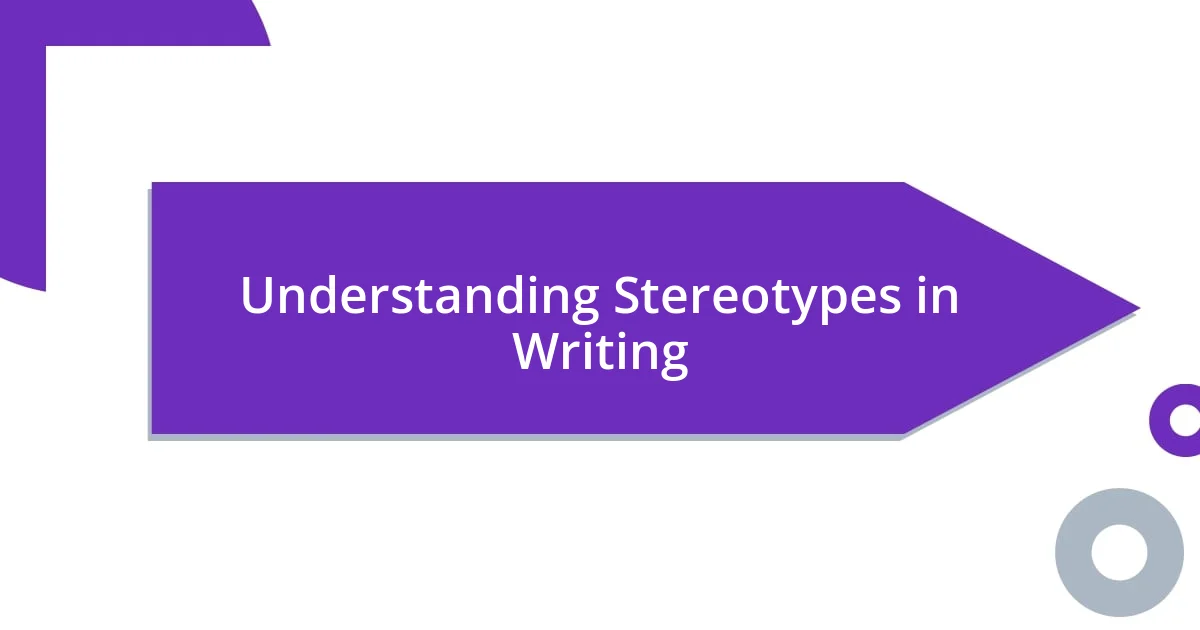Key takeaways:
- The importance of challenging stereotypes in writing helps create multi-dimensional characters that reflect authentic experiences and resonate with readers.
- Incorporating diverse perspectives enriches character development, allowing for deeper motivations and more relatable narratives.
- Characters can inspire real-world dialogue and change perceptions, demonstrating the power of literature to challenge societal norms and provoke empathy.

Understanding Stereotypes in Writing
Stereotypes in writing often emerge from societal norms, and they can shape how characters are perceived by readers. I remember my initial attempts at character development, where I unintentionally fell into the trap of clichés, depicting the “damsel in distress” or the “angry black man.” These oversimplifications not only reduce character depth but also reinforce harmful narratives that can resonate negatively in real life.
When I write, I constantly challenge myself to think about the broader implications of my portrayals. Aren’t we all more than the labels society places on us? By digging deeper into my characters’ backgrounds, motivations, and flaws, I find rich stories that resonate on a personal level, revealing the complexity of human nature rather than reducing it to mere tropes.
Understanding stereotypes is crucial because it allows writers to break free from formulaic narratives. I’ve come to realize that each character I create holds the power to reflect an authentic experience that defies expectations. This awareness ignites my passion for storytelling, driving me to craft characters that feel real and relatable, while inviting readers to question their own assumptions along the way.

Identifying Stereotypes in Characters
Identifying stereotypes in characters requires a keen eye for the subtleties in traits and behaviors that might be influenced by societal views. I often find myself reflecting on how certain characteristics may unintentionally echo broader stereotypes. For example, early in my writing journey, I created a supporting character who was, in my mind, “quirky and eccentric.” As I looked closer, I realized I had fallen into the stereotype of the “crazy artist.” Recognizing this allowed me to reshape her into a multidimensional person with her own struggles and dreams.
To effectively identify stereotypes in my characters, I consider several aspects:
- Dialogue Patterns: Are my characters using speech that harkens back to clichés?
- Background Stories: Do their histories reinforce stereotypes instead of adding depth?
- Motivational Depth: Are their goals and motivations unique or borrowed from typical tropes?
- Interaction Dynamics: How do they relate to other characters? Am I unknowingly following stereotypical paths?
- Visual Representations: What are the physical traits or appearances that could be misinterpreted?
Every time I scrutinize these elements, I can feel my characters becoming more authentic and relatable, inspiring me to dive even deeper into the reality of their stories.

Developing Multi-Dimensional Characters
Developing multi-dimensional characters is a task that excites me, as it allows exploration into the intricate layers of human experience. I remember crafting a character who initially seemed straightforward, like a wise mentor. However, as I developed their backstory, it became clear they carried deep-seated regrets and insecurities. That revelation transformed them, enriching their interactions and creating what I believe is a far more relatable figure.
When I think of my characters, I envision them as fully formed individuals, not just plot devices. Take, for instance, a character who is a single mother. Instead of just portraying her struggles in a dramatic light, I infused humor into her daily challenges, showing how her resilience shapes her relationships. This duality not only made her relatable but also highlighted her strength in a way that went beyond typical narratives of hardship.
Ultimately, building multi-dimensional characters demands a willingness to embrace their flaws and virtues alike. I often jot down traits that contradict one another—like a character who is incredibly confident yet fears intimacy. I’ve found that these contradictions mirror real-life complexities and help invite readers to see the characters as tangible, flawed beings with whom they can empathize.
| Aspect | Examples |
|---|---|
| Background Development | Expanding on a character’s history and life events to add depth. |
| Emotional Layers | Incorporating a mix of triumphs and failures to showcase complexity. |
| Relationships | Exploring how a character’s interactions with others reveal different sides of their personality. |

Incorporating Diverse Perspectives
Incorporating diverse perspectives is essential for creating a rich tapestry of characters. I’ve found that when I actively seek out voices different from my own, my writing not only becomes more vibrant but also profoundly insightful. One example that stands out for me was when I consulted with a friend who grew up in a vastly different culture. I was drafting a character from that background, and her insights brought dimensions to the character that I would have otherwise overlooked, making her story more genuine and relatable.
I also make it a point to include diverse experiences by reading literature from authors with different cultural backgrounds. This practice opened my eyes to unique storytelling techniques and character arcs. I remember reading a novel that beautifully depicted a generational clash within a family, showcasing how cultural expectations and personal desires often dance in conflict. Inspired by that, I began weaving similar themes into my own characters, ensuring that their narratives reflect the complexity of navigating multiple identities.
Furthermore, I often ask myself: how can I challenge my assumptions about others’ experiences? By embracing this question, I push beyond surface-level portrayals and delve into deeper motivations and values that shape my characters. I once shadowed a friend’s community discussion group, where I learned about their struggles and triumphs. That experience deeply influenced a character I was working on, allowing me to write with authenticity and emotional depth that resonated with readers. It’s moments like these that reinforce the importance of diverse perspectives in enriching character development.

Techniques to Challenge Stereotypes
One effective technique I use to challenge stereotypes is to create characters who defy traditional norms in unexpected ways. For instance, I once wrote about a tough, no-nonsense mechanic who, outside of work, spent her weekends in a local poetry club. This character’s passion for delicate expressions of emotion contrasted sharply with her gruff exterior, showcasing that strength comes in many forms. It truly illustrates that people are not defined solely by their professions or appearances, right?
Another approach I often take is exploring the impact of personal experiences on my characters’ choices. I remember developing a character who grew up in a wealthy family but chose to become a social worker—a narrative that flips the script on assumptions about privilege. By recounting her struggles with self-identity and her desire to make a difference, I was able to portray her complexity, inviting readers to rethink preconceived notions about wealth and success.
Lastly, I find it invaluable to give my characters agency in their stories. A time when I was writing about a young man from a marginalized community, I made sure that he wasn’t just a victim of his circumstances. Instead, he pursued his education relentlessly and became an advocate for change in his neighborhood. It’s powerful to depict characters as active participants in their lives, breaking free from stereotype-driven narratives and allowing readers to see them as proactive and multidimensional. Have you thought about how empowering your characters in this way could change the story you want to tell?

Examples from Literature and Media
One of the most compelling examples from literature that challenges stereotypes is the character of Atticus Finch in Harper Lee’s To Kill a Mockingbird. When I first encountered him, I was struck by how a single character could embody both moral integrity and deep empathy. Atticus defies the stereotype of a traditional lawyer by advocating for justice in a racially charged environment. He not only stands up for an innocent man but also teaches his children valuable lessons about compassion, forcing me to reevaluate what it means to be truly courageous.
In the realm of film, Crazy Rich Asians presents characters that defy the shallow portrayals often associated with wealth. Rachel, the protagonist, is more than just a love interest; she’s a complex woman navigating her identity and cultural expectations. I remember feeling an unsettling mixture of pride and discomfort as I saw aspects of my own journey reflected in her struggles between family loyalty and personal aspirations. This multi-layered approach highlighted how wealth can shape but not define one’s character, prompting me to think about how I can portray rich inner lives in my own stories.
Another memorable example comes from the graphic novel Ms. Marvel, featuring Kamala Khan, a Pakistani-American teenager. It was refreshing to see a superhero who wrestles with the challenges of being a Muslim in America while also juggling the typical issues of teenage life, like fitting in. I found Kamala’s journey particularly inspiring because it mirrors a narrative many readers can relate to, regardless of their background. It encourages me to think about how my characters can embody not just cultural identity, but also personal growth, showing that they can be heroes in their own narrative without fitting neatly into societal molds.

Measuring Impact on Readers
When I think about measuring the impact of my characters on readers, it’s fascinating to consider the feedback I’ve received over time. I remember a reader sharing how my portrayal of a character who struggled with mental health issues resonated with her. She felt seen and understood in a way that she didn’t expect from fiction. It’s moments like these that affirm the importance of challenging stereotypes—when a character’s journey mirrors the struggles of readers, it fosters connection and empathy.
Another way I’ve gauged impact is through discussions in writing groups or book clubs. One time, I was part of a forum where a participant mentioned how a strong female character I created prompted her to reassess her own preconceived notions about women’s roles in society. It fueled a lively debate about gender and strength, and I realized then how my characters could ignite conversations that extend beyond the pages of a book. Isn’t it amazing to think that fiction can inspire real-world dialogue?
Additionally, I’ve often turned to social media for insights. After one of my books released, I noticed a wave of posts where readers shared their favorite characters and how those characters challenged their perspectives. One comment struck me: a reader said she had never viewed a particular profession through a feminist lens until reading my story. It dawned on me that literature has the power to reshape narratives and provoke questions about identity, purpose, and societal constructs. How has literature challenged your own views?














